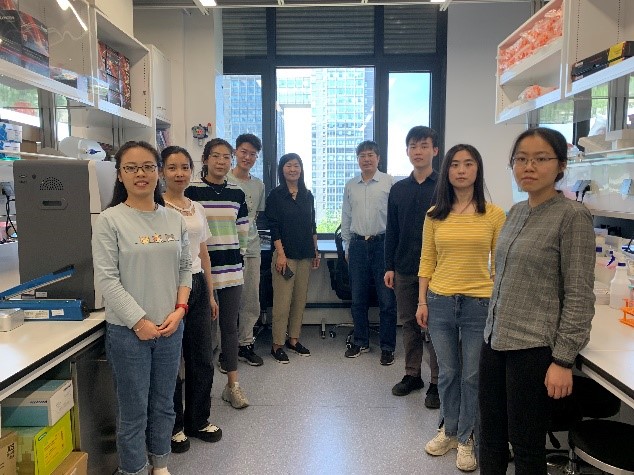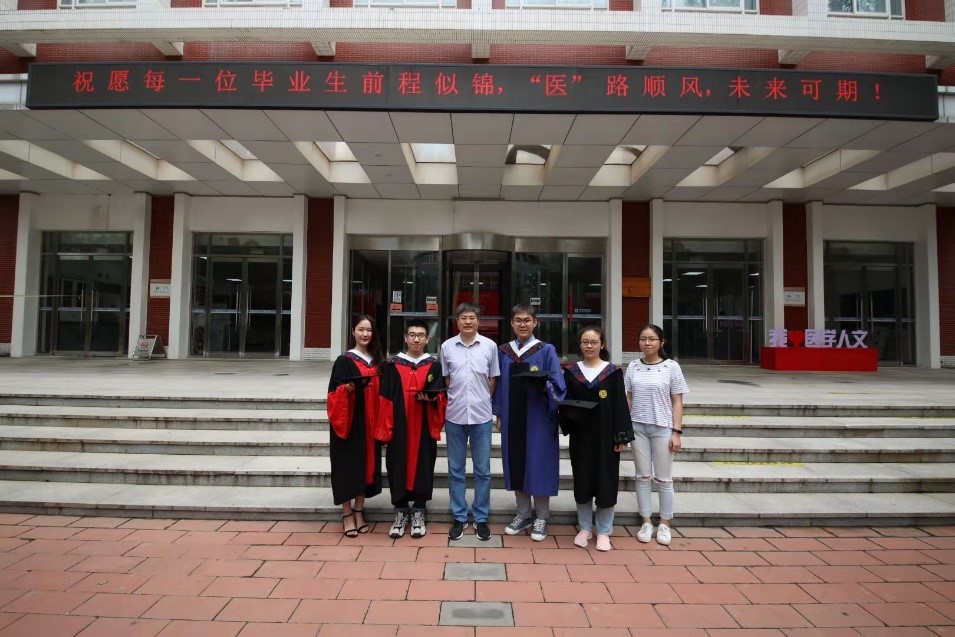教师队伍
王 杰 副研究员

王杰 副研究员
PI,博士生导师
办公室:医学科技楼北楼B602-2室
教育经历:
2012/09-2015/07,北京大学基础医学院,病原生物学系,医学博士
2008/09-2010/04,美国田纳西大学医学院,分子科学系,访问学者
2005/09-2008/07,北京大学基础医学院,病原生物学系,医学硕士
2000/09-2005/07,天津医科大学,医学检验学系,医学学士
工作经历:
2019/01-至今,北京大学基础医学院,病原生物学系,副研究员/博士生导师
2015/09-2018/12,北京大学基础医学院,病原生物学系,讲师
2011/07-2012/01,南开大学生命科学学院,微生物学系,研究助理
2010/07-2011/07,北京科兴生物制品有限公司,研发中心,研发工程师
主要从事乙型肝炎病毒(HBV)感染的预防和靶向治疗,HBV与宿主因子相互作用,以及病毒感染相关肿瘤发生机制方面的研究。现任中华预防医学会消除病毒性肝炎工作委员会委员、中国研究型医院学会病毒肿瘤学专业委员会委员、中华医学会医学病毒学分会青年学组委员、中华医学会肝病学分会青年学组、肝炎学组、肝癌学组、肝病基础医学与实验诊断协作组委员等。发表中英文文章90余篇,其中以第一或通讯作者在Gut、Journal of Hepatology、Small、Theranostics、Oncogene、Cell Death & Disease、Emerging Microbes & Infections、Journal of Virology等杂志上发表20余篇SCI论文。获得国家授权发明专利6项。曾获亚太肝病学会第4届乙肝专题会议青年学者奖、中华医学科技二等奖、北京大学医学部教学优秀奖、北京大学基础医学院教改优秀奖等奖项。

李杰 副教授
Co-PI,硕士生导师
办公室:卫生楼429室
邮箱:jieli@hsc.pku.edu.cn
教育经历:
2000/09-2002/07,北京大学基础医学院,病原生物学系,理学硕士
1994/06-1995/06,日本国立卫生研究所,病毒二部,访问学者
1987/09-1991/07,武汉大学,病毒及分子生物学系,理学学士
工作经历:
2002/08-至今,北京大学基础医学院,病原生物学系,副教授/硕士生导师
2001/03-2002/07,北京大学基础医学院,病原生物学系,助理研究员/讲师
1995/07-2001/02,中国疾病预防控制中心病毒病研究所,国家脊髓灰质炎参考实验室,助理研究员
1991/07-1994/06,中国疾病预防控制中心病毒病研究所,国家脊髓灰质炎参考实验室,实习研究员
主要从事乙型肝炎病毒(HBV)分子病毒学、预防及流行病学研究。现任中华医学会肝病学分会第八届常委兼秘书长,北京医学会肝病学分会常委、乙肝学组副组长。发表中英文文章130余篇,其中以第一或通讯作者在Gut、Emerging Microbes & Infections、BMC Medicine、BMC infectious Disease、Virulence、Virology Journal、Viruses、Journal of Clinical and Translational Hepatology、Vaccine等杂志上发表20余篇SCI论文。曾获中华医学科技一等奖和二等奖、卫生部医药科技进步二等奖、北京大学医学部优秀教师等奖项。

实验室成员合影


实验室团建合影

部分毕业生合影
近年主要承担课题:
1. 国家自然科学基金面上项目,2024.01-2027.12,负责人(王杰)
2. 国家重点研发计划,2023.12-2026.11,任务负责人(李杰)
3. 国家自然科学基金面上项目,2022.01-2025.12,负责人(王杰)
4. 国家自然科学基金面上项目,2020.01-2023.12,负责人(王杰)
5. 融合重点项目,2019.01-2022.12,子课题负责人(王杰)
6. 北京市自然科学基金面上项目,2018.01-2020.12,负责人(王杰)
7. 国家科技重大专项,2017.01-2020.12,子课题负责人(李杰)
8. 国家科技重大专项,2017.01-2020.12,任务负责人(王杰)
9. 国家自然科学基金面上项目,2017.01-2020.12,负责人(王杰)
10. 国家自然科学基金面上项目,2016.01-2019.12,负责人(李杰)
代表性论文:(#第一作者,*通讯作者)
1. Zheng H#, Liu M#, Shi S#, Huang H, Yang X, Luo Z, Song Y, Xu Q, Li T, Xue L, Lu F, Wang J*. MAP4K4 and WT1 mediate SOX6-induced cellular senescence by synergistically activating the ATF2–TGFb2–Smad2/3 signaling pathway in cervical cancer. Mol Oncol. 2024; 18(5):1327-1346.
2. Liu M#, Song Y#, Li Y, Yang X, Zhuang H, Li J*, Wang J*. C2729T mutation associated with HBV mother-to-child transmission reduces HBV production via suppressing LHBs expression. Virulence. 2023; 14(1):2189676.
3. Huang H#, Han Q#, Zheng H, Liu M, Shi S, Zhang T, Yang X, Li Z, Xu Q, Guo H*, Lu F, Wang J*. MAP4K4 mediates the SOX6-induced autophagy and reduces the chemosensitivity of cervical cancer. Cell Death & Disease. 2022; 13(1):13.
4. Lu Y#, Song Y#, Zhai X, Zhu F, Liu J, Chang Z, Li Y, Xiao Y, Li L, Liu M, Liu J, Duan Z, Zou H, Zhuang H, Wang J*, Li J*. Maternal Hepatitis B e Antigen can be an Indicator for Antiviral Prophylaxis of Perinatal Transmission of Hepatitis B Virus. Emerg Microbes Infect. 2021; 10(1):555-564.
5. Xiao Y, Sun K, Duan Z, Liu Z, Li Y, Yan L, Song Y, Zou H, Liu J, Zhuang H*, Wang J*, Li J*. Quasispecies characteristic in “a” determinant region is a potential predictor for the risk of immunoprophylaxis failure of mother-to-child-transmission of sub-genotype C2 hepatitis B virus: a prospective nested case-control study. Gut. 2020; 69(5):933-941.
6. Li Y#, Liu Z#, Song Y, Xiao Y, Jiang J, Li L, Zhai X, Liu J, Duan Z, Ding F, Liu J, Zhuang H, Zhu L, Jiang J, Zou H, Wang J*, Li J*. Reduction of the occurrence of occult HBV infection in infants by increasing the dose of hepatitis B vaccine: A large prospective cohort study. Emerg Microbes Infect. 2020; 9(1):1881-1891.
7. Chen R, Huang H, Liu H, Xi J, Ning J, Zeng W, Shen C, Zhang T, Yu G, Xu Q, Chen X, Wang J*, Lu F*. Friend or Foe? Evidences Indicate Endogenous Exosomes Can Deliver Functional gRNA and Cas9 Protein. Small. 2019; 15(38): e1902686.
8. Wang J#, Chen R#, Zhang R#, Ding S, Zhang T, Yuan Q, Guan G, Chen X, Zhang T, Zhuang H, Nunes F, Block T, Liu S, Duan Z, Xia N*, Xu Z*, Lu F*. The gRNA-miRNA-gRNA ternary cassette combining CRISPR/Cas9 with RNAi approach strongly inhibits hepatitis B virus replication. Theranostics. 2017; 7(12):3090-3105.
9. Wang J#, Shen T#, Huang X#, Kumar GR#, Chen X, Zeng Z, Zhang R, Chen R, Li T, Zhang T, Yuan Q, Li PC, Huang Q, Colonno R, Jia J, Hou J, McCrae MA, Gao Z*, Ren H*, Xia N*, Zhuang H, Lu F*. Serum hepatitis B virus RNA is encapsidated pregenome RNA that may be associated with persistence of viral infection and rebound. Journal of Hepatology. 2016; 65(4):700-710.
10. Wang J, Ding S, Duan Z, Xie Q, Zhang T, Zhang X, Wang Y, Chen X*, Zhuang H, Lu F*. The role of p14ARF-HDM2-p53 in SOX6-mediated tumor suppression. Oncogene. 2016; 35(13):1692-1702.

